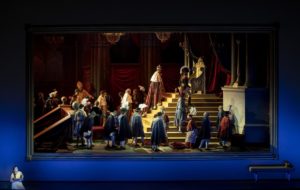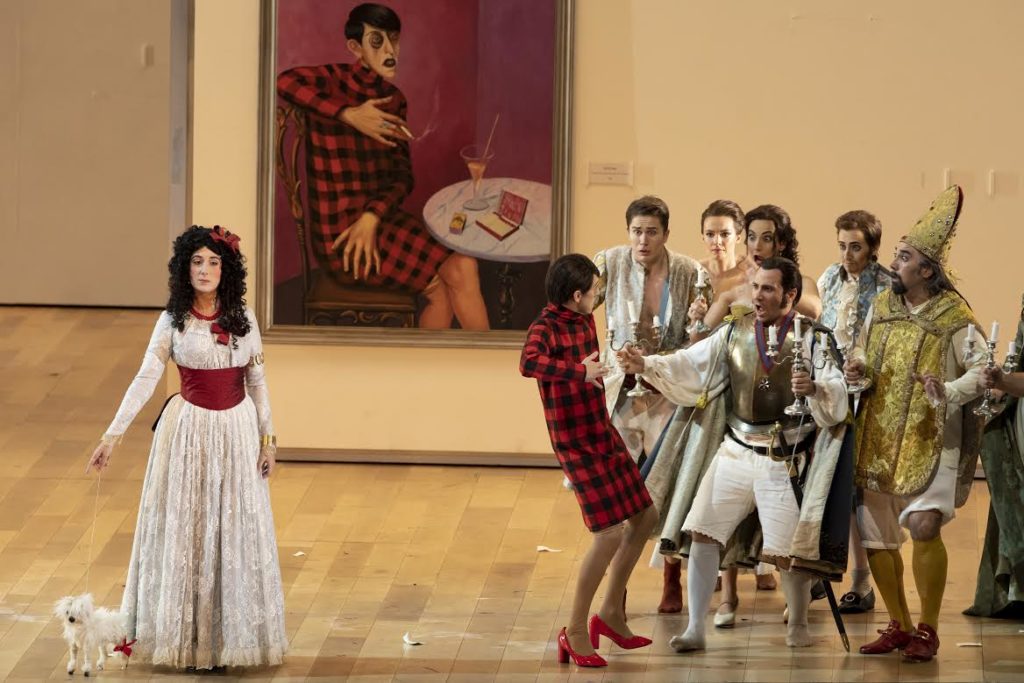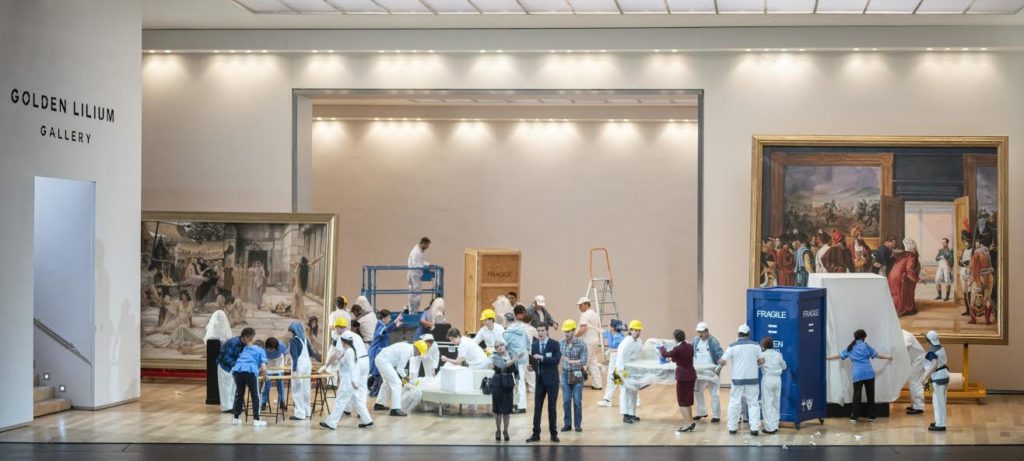
Palau de Les Arts 2019-20 review: Il Viaggio a Reims
Damiano Michieletto & Francesco Lanzillotta Lead Witty Take on Challenging Rossini Work
By Mauricio Villa(Credit: Miguel Lorenzo/Mikel Ponce)
Rossini’s “Il viaggio a Reims” is a difficult show to stage.
To begin with, it was written as a “cantata” and not an opera, and it has 14 solo voices. Moreover, it is a compilation of Rossini’s past compositions, including his opera buffa and serious works, but with a stronger influence of the French “Grand Opera” which definitively marks Rossini’s last operas.
In essence, you need a director to stage something which was not intended for that purpose and a good conductor who can adapt on the fly. Then there’s the question of the singers.
The Palau de Les Arts succeeded with one of the best productions of this work, thanks to an adequate conductor and a mostly excellent cast of singers.
I must say that when you have a theatre director who defines and works the characters like Damiano Michieletto, the result is that the whole cast of singers give excellent acting performances. This was undeniably the case.
Female Stars
Ruth Iniesta, who played Madama Cortese (in this case the owner of the gallery) sang her entrance aria “Di vaghi raggi adorno” with determination showing her clever use coloratura in a role which might be, in my opinion, too low for her. She showed a tendency to exaggerated the vibrato when singing over high A, making those high notes sounded a bit strident despite of the potency of her voice. Being a Lirico leggera, maybe the role of the Contessa di Follevile would have been a better choice. The role of Madama Cortese has a central writing and is immensely immensely florid, but her aria does not go higher than A natural and the cabaletta moves up to a B flat. The role also has three bombastic ascensions to high C during the Act one sextet and due to the qualities of Iniesta’s voice, the notes were present over the rest of the five soloists and orchestra. However, her vibrato on the high Cs tended to sound strident. Fortunately, her personification of the selfish arrogant owner of the gallery was superb.
Albina Shagimuratova, who sang the Contessa di Folleville, shined in her aria “Partir, o ciel! Desio!” She delivered a full display of quick scales, rotulades, staccato notes, high notes, trills and crystalline pianissimo like her high B flat on “provato.” She has a beautiful timbre, with some weight in the middle and an astonishing facility to sustain high notes as she proved in her final interpolated high E flat. Her own variations were exquisite and in style and she included several extra high D flats and E flats.
Her acting proved very hilarious during her aria, as in Michieletto’s direction, the Contessa has lost her shoes ( in the libretto she has lost all her luggage and has no clothes, but finally just a luxury hat arrives) and she being given numerous pairs of shoes that she despises and throws away. Eventually, she finds a decent pair of shoes that she feels comfortable with in time for her cabaletta. The audience laughed on several occasions and she received a big ovation after the aria.
Corinna was sung by Mariangela Sicillia who had already portrayed this role in this production back in 2017 in Rome. She has one of the longest roles in this composition with two arias and a long duet. The tessitura is quite central with a tendency to go under the stave, as the several written low A naturals in her first aria “Arpa gentil.” It is true that despite the low notes it is not a heavy role as many passages are written with only harp accompaniment.
Sicillia sang her first aria off-stage with dark crystalline timbre with well-supported low notes, fluid vocal line, and clean roulades. She managed piannisimi on interpolated high notes with ease, especially on the cadenza when she interpolated a floating piano high A natural at the end of her first verse.
In her duet with Cavalie Belfiore, the tessitura becomes a truly lyrical one, always central but this time going above to stave to high A frequently and a few high B naturals, especially on the line “un tal eccesso è indegno dell’onor;” this line chromatically ascends to a forte B natural, followed by a diminuendo which Rossini wrote for the tenor twice. In this edition, Sicillia got the second high note ( probably under the supervision of Lanzillota, or maybe because they use a critical edition).
The highlight of her performance was her final aria “All’ombra amena” at the end of Act two, again with harp accompaniment. She sang with exquisite beauty, managing several ascensions to high B naturals with effortless piannissi, especially in the final cadenza.
In all the arias, Corina is making a sketch of the picture of the coronation of Charles X that is forming in slow motion inside a huge frame hanging on the stage. Her portrayal of the ingenious art student was really amusing.
The last important female role, the Marchesa Melibea, was interpreted by the mezzo Marina Viotti. Her part does not have a big aria, so her big moment is her long duet with Libenskorf in Act two, where she showcased adequate Rossinian style with clean coloratura, a balanced timbre from the lowest to the highest register and an even vibrato.

(Credit: Miguel Lorenzo/Mikel Ponce)
The Male Stars
The role of Conte di Libenskof, a typical Rossini tenore di grazia role, was preform by Sergey Romanovsky. He has the tessitura for the role, which includes at least a high C every time he appears and high vocal writing that moving up to high B flat and high C. His voice is small and lacking in projection, and even if his high notes are secure (although one of his high Cs broke during the sextet of the first act) the notes are gargled and guttural, sounding muffed, distant, and cloudy. The interpolated ending high C of “Onore, gloria ed alto omaggio” was swallowed by the orchestra. Because his voice was so guttural his coloratura did not sound clean and precise. His acting was quite discreet as well, resulting in one of the disappointments of the night.
On the other hand, other tenor Ruzil Gatin, who played Cavalier Belfiore, shined for his grateful Lirico leggero voice which has resonant projection and a balanced timbre throughout the register. Even if the vocal writing is slightly lower than Libenskof, his lines are full of High B flats and B naturals and the general tessitura is quite high. But he still interpolated several extra high B naturals during his duet with Corina, which is his big moment. At the beginning he is posing for Corina, as she draws a sketch of him, with the intention of gaining her heart. When he fails, he threatens one of the gallery visitors with his sword and forces him to take off all his clothes so that he can wear his modern clothes and approach Corina. Michieletto makes this semi-naked visitor cross the stage from side to side in front of the 14 soloists throughout the Finale concertato, creating a comic situation.
Lord Sidney, portrayed by Rumanian bass Adrian Sampetrean, is another of the few characters who has a big aria with cabaletta. If we look at the score, Rossini makes no distinction between baritone and bass, and all low male voices are categorized as basses. However, the tessitura is clearly baritonal with lines going constantly up to high E and high F. I believed that Sampetrean was not vocally comfortable with the part, as even if his voice showed some rotundness and expression. He managed the florid high tessitura was by making his voice small, but the result was a distant sound and blurred coloratura. When he went up to a sustained high F at the end, he did not create a bombastic effect as the note sounded guttural and small. I have to say that at least he had a clear Italian diction. He represented a restorer who is working on an old canvas, so his aria is full of actions. And it is a magical moment, as the picture of a woman he is working on comes to life to an embrace him. Then all the other characters in the pictures hanging in the gallery also come to life.
Don Profondo, sung by Misha Kira, has his big moment during his buffo aria in Act one. He sang with a perfect Italian diction, following the quick tempo of the aria effortlessly, and imitating several accents:: Spanish, Polish, German, French. His voice has depth and volume and he interpreted the aria with a defined vocal line, something very hard in a buffo part full of parlato moments. It was very surprising the use of mezza voce and nice balanced falsetto during her short duet with Madama Cortese in Act two.
The scene was not an easy task as he represents an auctioneer from the gallery. Michieletto made the people in the auction enter through the auditorium and stay in the middle of the central aisle while auctioning, bringing the audience into the scene. Even the conductor places a bit.
Il Barone de Trombonok, the other basso buffo part in this opera, was sung by Fabio Capitanucci with a rotund bass voice and clear comical intentions that worked. But this character, who is very important for the plot, has no big singing moment, and despite his short German song in Act two, his appearances were relegated to ensemble pieces or spare lines. But Capitanucci was very convincing both vocally and comically.
The Choir de la Generalitat Valenciana and the many other soloists were quite fantastic in their respective parts.

(Credit: Miguel Lorenzo/Mikel Ponce)
A Clever Take
Damiano Michieletto directed a clever, funny, and dynamic production. “Il viaggio a Reims” happens in a health resort in 1825 where several personalities from the European aristocracy gather to rest before continuing with their respective journeys to see the coronation of Charles X in Reims. Instead, Michieletto sets the opera in an art gallery in modern times and deals with lost characters from a canvas in their period underwear (only wearing elements of clothes to identify them like capes, coats or hats) as they eventually find their place in a big canvas which represents the coronation of Charles X. When stage directors follow a dramaturgy that is written completely outside the libretto, 98 percent of the time, this made-up nonsense ends up confusing the audience. But Michieletto’s concept respects the music, justifies the libretto and is witty and hilarious.
The young versatile conductor Francesco Lanzillotta presented a fresh reading of the score with moderate tempi and building tension in the Rossinian finales, rather than just increasing the tempo and intensity of the orchestra. What is more, he found a perfect balance between the voices and the orchestra as the singers (with a few exceptions), something very hard to achieve in this theatre which has a big pit completely open with the acoustics favoring the larger ensemble.
Lanzillota proved knowledgable of the Rossinian style by attending to all the needs required in the secco recitative, arias and ensembles to make the sound light, lively but loaded with emotion. He even amusingly joined the staging during Don Profondo’s aria as he bid for a helmet from the pit and had one extra bring the article from the stage and place it on the conductor’s head to end the piece. The orchestra sounded brilliant, particularly the harp soloist during Corinna’s aria “A’ll ombra amena”.
Ultimately, it was a complete success, despite some inadequate voices, and the audience left cheerful and energetic after the performance. A huge reason for this is the undeniably magical staging and the witty but energetic approach from Lanzillota in the pit.


